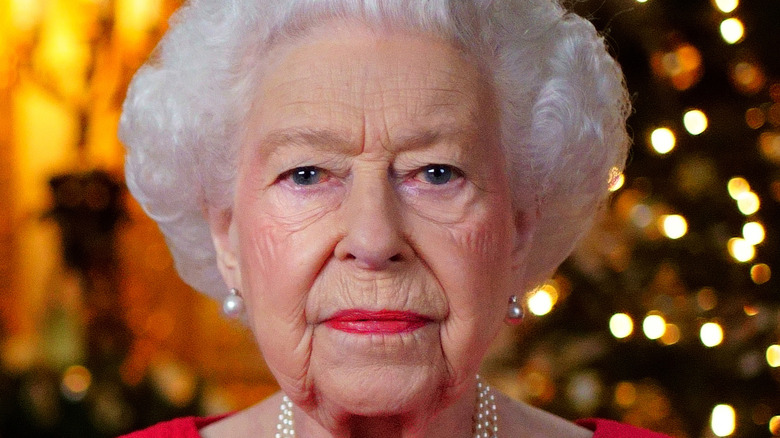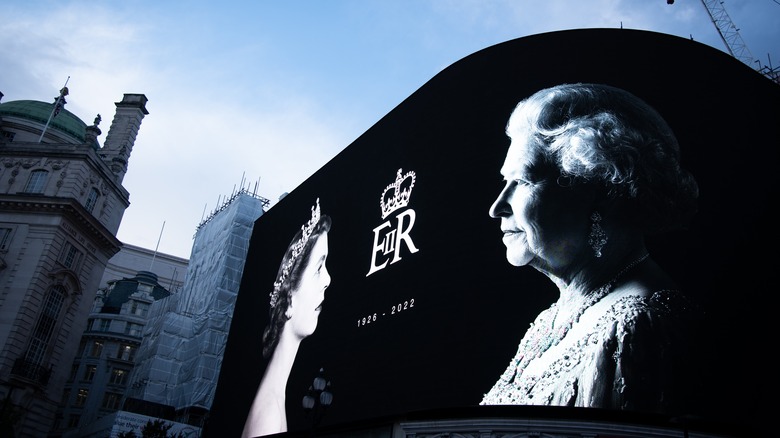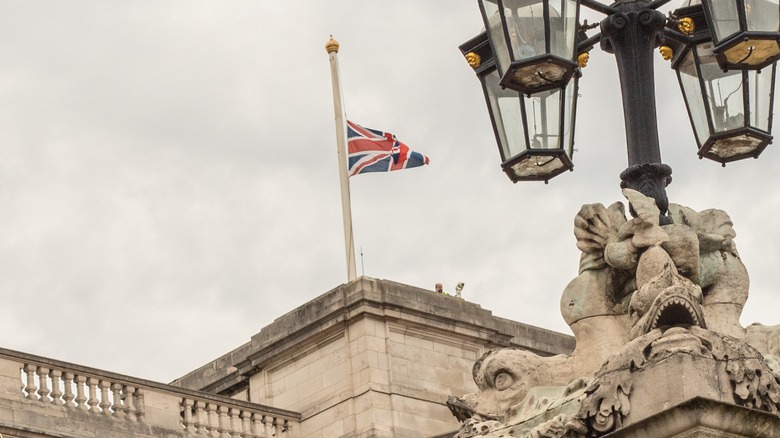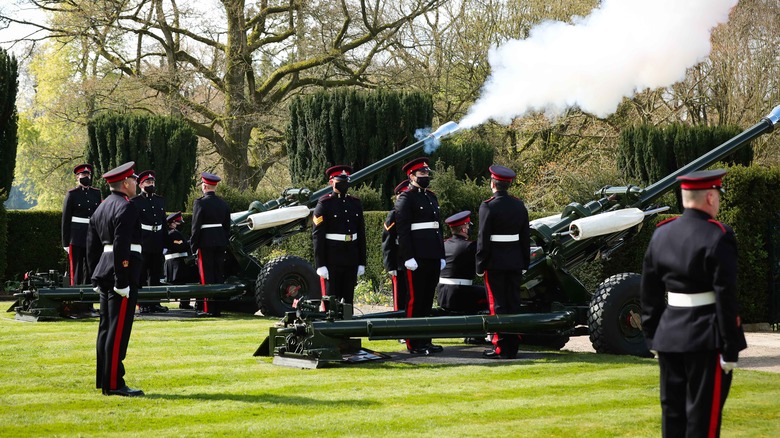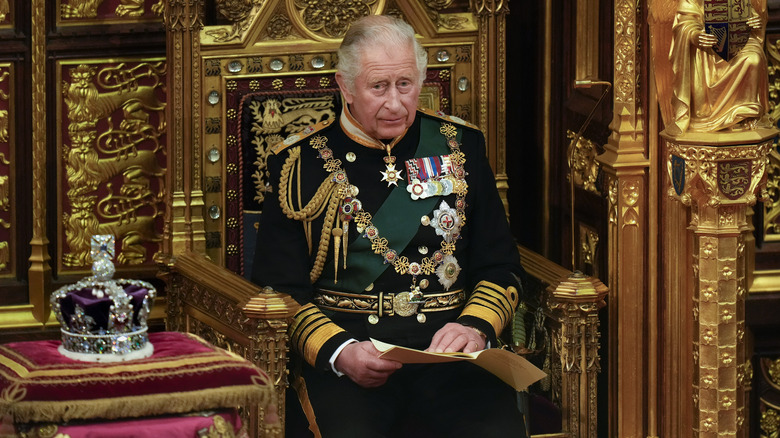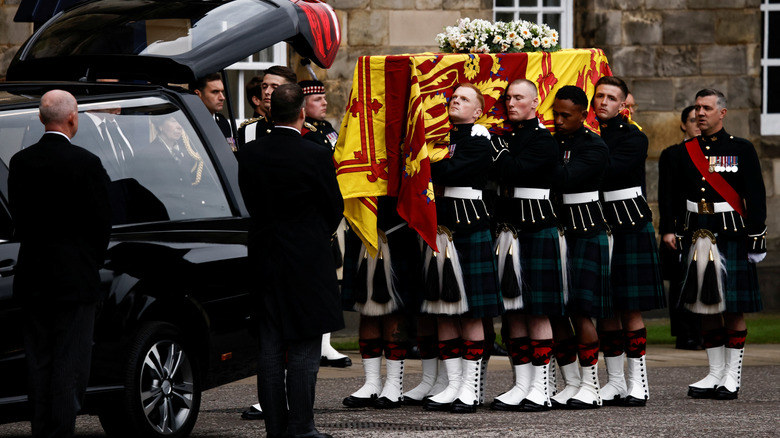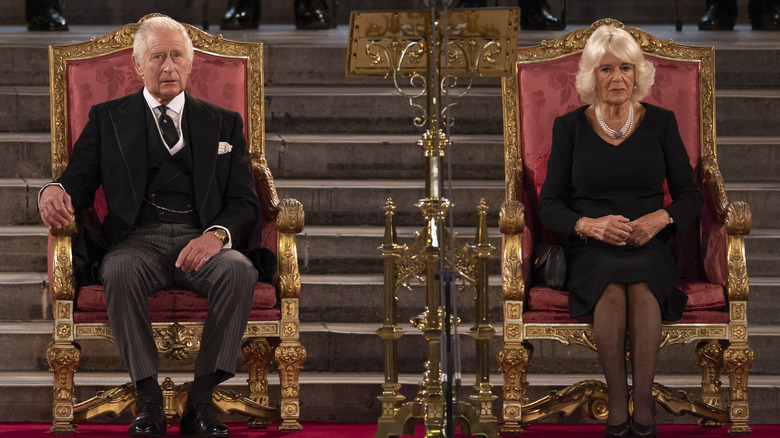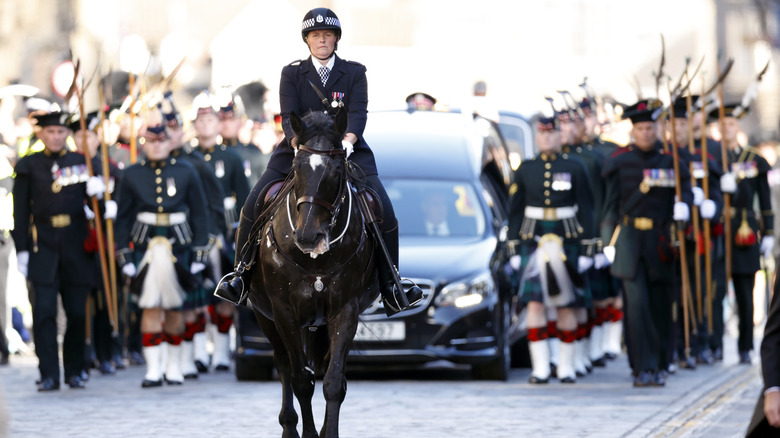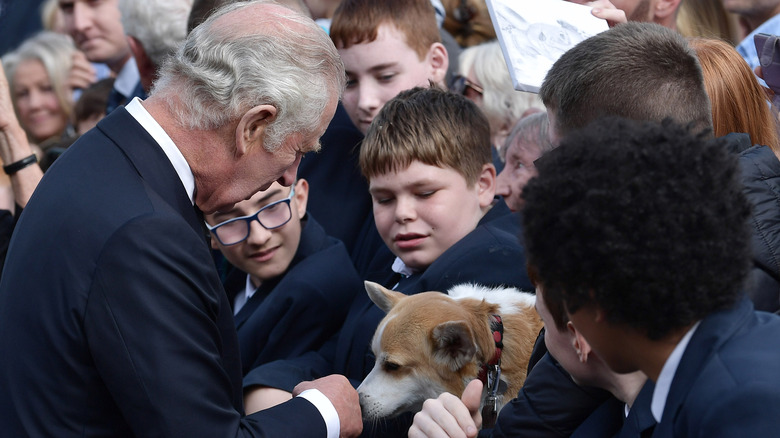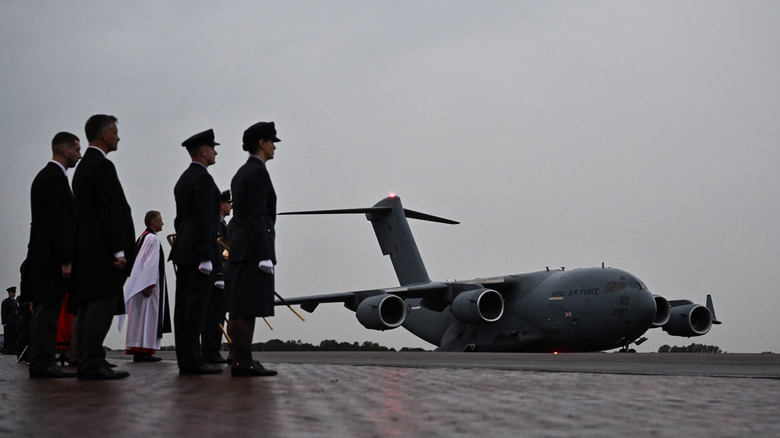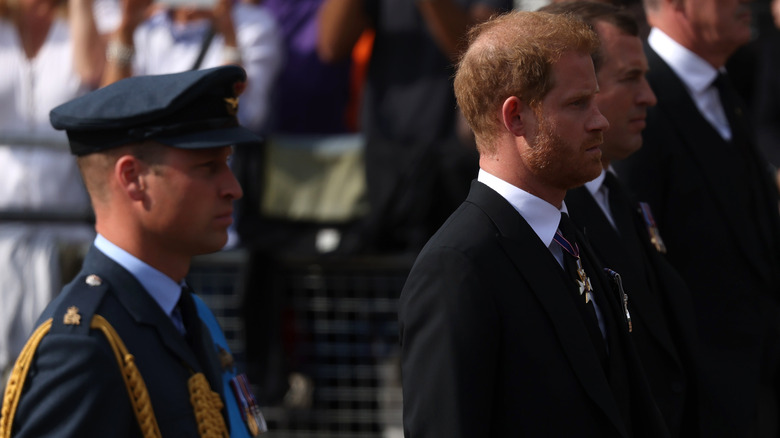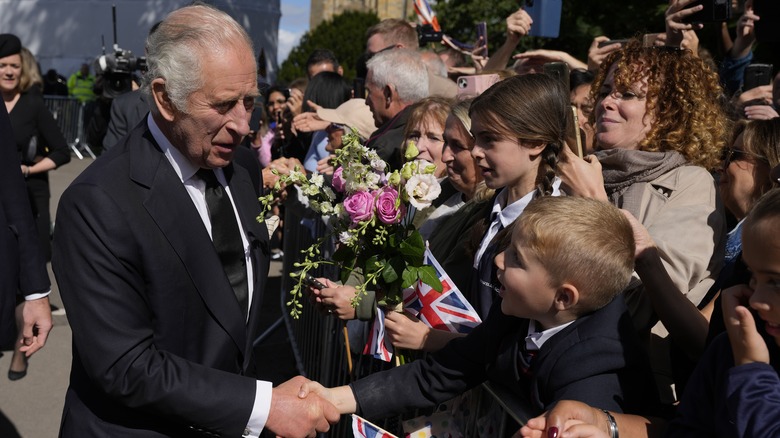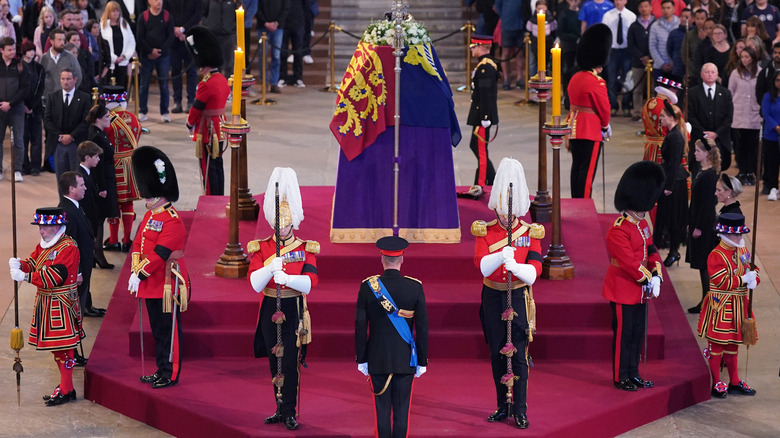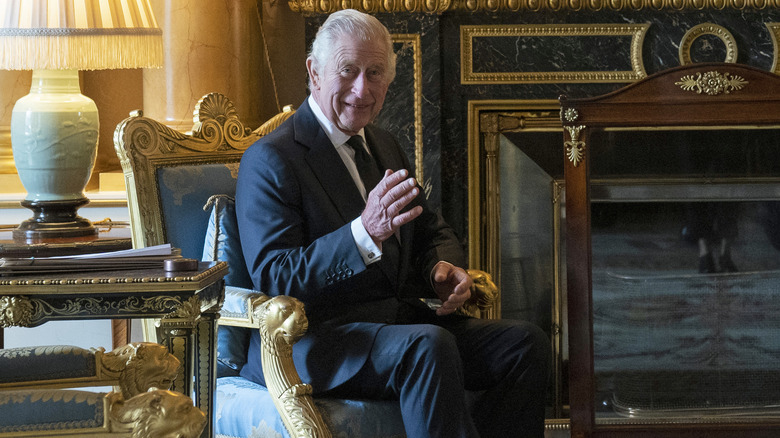A Complete Timeline From The Queen's Death To The Crypt
In 1929, when Queen Elizabeth II appeared on the cover of Time magazine at the innocent age of three, it became obvious that the then-princess would become subject to the close watch, scrutiny, and royal trials and tribulations as the result of her bloodline. Unlike her predecessors who lived in an era before the behemoth of an industry known as the modern media, cameras and the internet documented her every move throughout her lifetime — something that hasn't changed even after the queen's passing on September 8, 2022.
In the day leading up to her death, BBC News reported that the queen was under medical supervision after evaluation from her doctors. The program shared a statement from Buckingham Palace: "Following further evaluation this morning, the Queen's doctors are concerned for Her Majesty's health and have recommended she remain under medical supervision." Noting that it was strange and uncommon for Buckingham Palace to disclose the queen's typically private medical status, the British broadcasting service begins to insinuate what may be at stake.
It was confirmed that both King Charles III (then Prince Charles) and Princess Anne remained at the queen's bedside in her final hours — just in time to bid their final farewells to their mother (via Australian Broadcasting Corporation). As more and more members of the royal family flocked to the queen's Balmoral estate and Buckingham Palace, the royal family released the statement the world had been dreading: "The Queen died peacefully at Balmoral this afternoon."
U.K. channels pause broadcasts to honor the queen
Seconds after the royal family released a statement informing the world of the queen's death, Welsh journalist Huw Edwards broke the news on BBC (via RX:TV). Edwards, dressed in a black suit, was ready for the moment. It is BBC's dress code to wear dark colors while appearing on air when a member of the Royal Family passes away (via The Guardian). Radio and television broadcasts across the nation were interrupted to bring news of the queen's death, with channels like BBC Three and BBC Four being suspended completely and replaced with static captions.
Music channels on the radio were switched out with melancholy music as TV programs "scrambled" to suspend airing and figure out ways to remove advertisements (via RX:TV). In regards to the scheduling of on-air broadcasts, BBC released a statement: "At this current time, schedules across all BBC service are subject to change. Due to the number of changes, it is possible that the electronic programme guides (EPG's) may not reflect what is being broadcast."
Flags are flown at half-mast
After the nation's dismay at the Palace's decision not to lower the flags to half-mast following the death of Princess Diana in 1997 — which was the custom for all royal deaths at the time — the queen ordered a new protocol that would require flags to be flown at half-mast upon the death of a royal (via BBC News). In 2021, this protocol was followed after Prince Philip's death. As news of Queen Elizabeth's passing spread across the United Kingdom, flags began to lower nationwide, including at Buckingham Palace.
The flag of Balmoral Castle, the queen's residence in Scotland, was lowered shortly after her death, and the Prime Minister's official residence, 10 Downing Street, quickly followed suit by lowering all flags on the premises. Cardiff Castle in Wales descended its flag with leading officials addressing the nation to pay their respects. The U.K. government released instructions immediately following the queen's death, advising that "all official flags, including the Union Flag, should be half-masted from as soon as possible today until 08.00 the day following The Queen's State Funeral."
Across the pond, President Joe Biden also ordered all American military and federal facilities to lower their flags to half-mast in remembrance of the queen (vis U.S. News & World Report).
Gun salutes and bell ringings for the queen are held across Wales
On September 9, the day after the queen's death, members of Parliament gathered to share their fond memories and recollections of the monarch, BBC News reported. Dressed in dark ensembles per royal custom, the current and ex-members exchanged moments of silence accompanied by exuberant laughter over stories of the queen.
According to the BBC, former Prime Minister Theresa May shared a story that highlighted the queen's sense of humor. As May detailed, she was helping to prepare a picnic at Balmoral when she dropped a piece of cheese on the ground, only to return it to the plate. To her mortification, she noticed the queen had seen the entire exchange. "I looked at her. She looked at me. And she just smiled. And the cheese remained on the table," May shared as MPs burst into uproarious laughter.
While Parliament found solace in each other and their memories of the queen, gun salutes and bell-ringing ceremonies could be heard outside. Cardiff Castle fired off 96 rounds to commemorate the queen's 96 years of life (via BBC News). Additionally, the Sebastopol bell at Windsor was rung 96 times. Churches in Wales were also "encouraged" to participate in bell ringing, BBC Wales News revealed.
Prince Charles becomes King Charles III and addresses the nation
Upon the death of Queen Elizabeth II, Prince Charles became King Charles III and Camilla became queen consort. Together, they set out from Balmoral to Buckingham Palace, where they greeted huge crowds of mourners outside the palace gates, as reported by BBC News. The new monarch was welcomed with handshakes and flower memorials in remembrance of his mother — his first interactions with the nation before entering the palace for the first time as king.
King Charles then made his first formal address. The king declared a period of mourning until the queen's burial, stating, "In a little over a week's time we will come together as a nation, as a Commonwealth and indeed a global community, to lay my beloved mother to rest. In our sorrow, let us remember and draw strength from the light of her example. On behalf of all my family, I can only offer the most sincere and heartfelt thanks for your condolences and support. They mean more to me than I can ever possibly express" (via BBC News).
As Charles ascended the throne on September 10, 2022, 21-gun salutes sounded at Colchester, as well as "the Tower of London, Cardiff Castle, Edinburgh Castle, Castle Cornet, Gibraltar, and naval bases and stations at sea," according to the BBC. Military members expressed their deep honor and pride that came with being a part of the proclamation. "This is a once-in-a-lifetime career opportunity for both myself and all of my soldiers," battery commander Maj Doug Collett, of the 7 Parachute Regiment Royal Horse Artillery, said. "It is something, I have no doubt, they will remember for the rest of their lives."
The queen's coffin arrives in Edinburgh
A statement from the royal family shared what exactly the queen's enduring relationship with Scotland was like: "The Queen was open about her affection for Scotland throughout her reign. Generations of her family have enjoyed the beauty of its countryside, and Her Majesty has met Scots from all walks of life during Investitures, Garden Parties and her many visits to the regions."
Due to Queen Elizabeth's well-known love and respect for Scotland, it was only natural that the country had its chance to honor the monarch following her death. Elizabeth set out to Scotland for one final journey and, upon arriving in Edinburgh, the queen's coffin was greeted by mourners, filling every inch and corner of the city to pay their respects to the beloved queen (per CBS News). The hearse made its way through the capital, passing by tributes and large bouquets made for the procession. As the coffin left Scotland, it could be seen draped in the Royal Banner of Scotland.
King Charles III makes his first speech to Parliament
On September 12, the king and queen consort traveled to Westminster Hall and were welcomed with a condolence ceremony from the House of Commons and the House of Lords. With 900 Parliamentarians in attendance, all dressed in mourning attire, the occasion represented Parliament's allegiance to the queen, with one member stating, "There is nobody in either House who has taken an oath of allegiance to anybody other than Queen Elizabeth. I've been here 52 years, I've taken the oath 14 times. On Saturday for the first time to the new King" (via BBC).
Addressing the king on behalf of the House of Commons, Speaker Sir Lindsay Hoyle said, "as deep as our grief is, we know yours is deeper," per BBC. "We know that you will bear those responsibilities which fall to you with the fortitude, dignity, demonstrated by Her late Majesty," Hoyle told the king. Charles replied, in his first speech to Parliament, "While very young, Her Late Majesty pledged herself to serve her country and her people and to maintain the precious principles of constitutional government which lie at the heart of our nation. This vow she kept with unsurpassed devotion." Charles further acknowledged how the queen set an example of selflessly serving her duty. "With God's help and your counsels," he continued, "I am resolved faithfully to follow."
The St. Giles Cathedral procession takes place
According to the royal family's official website, the queen's coffin began its procession from the Palace of Holyroodhouse to St. Giles' Cathedral on September 12. This occasion would mark the first time that all four of Queen Elizabeth's children were seen together publicly following their mother's death. "King Charles, the Princess Royal, Prince Andrew and Prince Edward were walking behind the Queen's hearse as it made its way towards St Giles' Cathedral in Edinburgh," BBC News reported. All were dressed in military attire sans Prince Andrew, who was wearing a mourning suit, as he is not a working royal. As noted by the BBC, Anne had "faithfully accompanied" her mother's coffin since it left Balmoral.
Once the coffin arrived at the cathedral, a service of thanksgiving was conducted to honor the life of Her Majesty, per the royal family's website. The service featured choir music from the St. Giles Cathedral choir, and bible readings from the minister. It was concluded with a singing of the National Anthem by all in attendance. The congregation remained standing as the royal family made their departure out of the cathedral — where the queen's coffin would rest for 24 hours.
King Charles III makes a diplomatic visit to Northern Ireland
On September 13, King Charles III arrived in Northern Ireland for his first trip to the country as king (via BBC). The king and Camilla, Queen Consort, landed at the George Best Belfast City Airport and were welcomed to the country with gifts. Before traveling to Hillsborough Castle, the couple met with gatherers of the public on the main street and paused to view the flowers left for Her Majesty.
The king shortly thereafter met with several Irish politicians, including Chris Heaton-Harris, the Secretary of State for Northern Ireland. Charles remarked to crowds at the castle, "In the years since she began her long life of public service, my mother saw Northern Ireland pass through momentous and historic changes. Through all those years, she never ceased to pray for the best of times for this place and its people" (via Australian Broadcasting Corporation). King Charles and the queen consort then made their way to St. Anne's Cathedral, where a memorial service was held for Queen Elizabeth II. The head of the Church of Ireland, Archbishop of Armagh John McDowell, praised the queen for her efforts to bring peace to Ireland, per BBC News.
This visit to Northern Ireland marked the utmost importance for King Charles III, as this was a chance to prove himself as a diplomat. Party leaders of Sinn Fein, the Irish Nationalist Party, did not attend the king's proclamation, as they "had no allegiance to the British crown," per ABC. The party and the British unions share a bloody history — one that they are slowly reconciling as we can see from King Charles' visit.
The queen's coffin leaves Edinburgh
September 13 marked the final day of the queen's posthumous visit to Scotland. After spending 24 hours in the St. Giles Cathedral, Her Majesty's coffin departed, making its way back to England and arriving at Buckingham Palace, according to the royal family's official website. The coffin was transported from Edinburgh airport in a Royal Air Force plane.
Awaiting the coffin's arrival at Buckingham Palace were the queen's children and grandchildren, including Duchess of Sussex Meghan Markle and Princess Catherine, according to BBC News. As rain poured onto the streets of London, the hearse, followed by a car transporting Princess Anne, drove past crowds of thousands waiting to pay their respects — many even lowering their umbrellas out of respect when the hearse rode by.
Princess Anne later released a statement about the event, writing, "Witnessing the love and respect shown by so many on these journeys has been both humbling and uplifting. We will all share unique memories. I offer my thanks to each and every one who share our sense of loss. We may have been reminded how much of her presence and contribution to our national identity we took for granted" (via Yahoo).
Princes William and Harry walk behind a coffin once again
September 14, the day after Queen Elizabeth's coffin arrived in London, was a bittersweet day around the globe. The coffin would travel to Westminster Hall from Buckingham Palace for a military procession, as outlined on the royal family's official website. Adorned with the Royal Standard, the Imperial State Crown, and a wreath, the coffin was carried on a horse-drawn gun carriage of the King's Troop Royal Horse Artillery. "His Majesty The King, The Princess Royal, The Duke of York, The Earl of Wessex, The Prince of Wales, The Duke of Sussex, Mr. Peter Phillips, The Earl of Snowdon, The Duke of Gloucester and Vice Admiral Sir Tim Laurence processed behind the coffin," according to the royal family.
As noted by BBC News, the sight of Princes William and Harry trailing behind their grandmother's coffin was quite reminiscent of Princess Diana's funeral 25 years ago, when the princes were just boys walking behind their mother's casket. As endearing as it was to see the brothers reunited once again, the circumstances of such a reunion were profoundly heartbreaking.
Guns fired by the minute as the coffin progressed toward Westminster, and Big Ben tolled each minute. After the procession, a small church service for the queen was conducted at Westminster. From there, the queen's lying-in-state began — a British royal custom in which a deceased royal is placed publically to allow the nation to pay their respects. There the queen remained until September 19, four days after she was carried through the procession to Westminster.
The king and queen consort visit Wales
While the queen was lying-in-state, other members of the royal family continued to tour and travel to other parts of the United Kingdom. On September 16, King Charles III and Camilla, Queen Consort, finally concluded their tour of the four nations of the United Kingdom — this time paying a visit to Wales. Wales conducted much preparation for the king, including the paving of potholes, painting of posts, and trimming of hedges, per BBC News. "It's like a sleepy town has become a wide awake town, everyone is so excited," a Llandaff resident told the BBC.
The royal couple arrived to the sounds of a gun salute from Cardiff Castle. The king spent several moments greeting and chatting with individuals of the 2,000 that had shown up on the castle grounds before his departure for Welsh Parliament (via BBC). Once there, King Charles addressed the members of the Parliament in Welsh and English. "I am deeply grateful for the addresses of condolence which so movingly paid tribute to our late sovereign, my beloved mother the Queen," he said (via Longview News-Journal). The king went on to speak of his "immense gratitude for the privilege of having been able to serve as Prince of Wales," and the honor it would be to pass the title onto his eldest son, Prince William.
The queen's eight grandchildren stand vigil at her coffin
On the evening of Saturday, September 17, the queen's eight grandchildren gathered around her coffin for what would be recognized as a "historic vigil," according to NBC News. Prior to the event, Prince Harry made headlines when it was announced that he would be allowed to arrive in military uniform despite no longer being an active member of the royal family. According to BBC News, the king granted such permission.
Known as the Vigil of the Princes, this ceremony for the queen marked the first time in history that the special vigil was held by a monarch's grandchildren, per BBC. In a tribute to their grandmother ahead of the monumental event, grandchildren Beatrice and Eugenie stated, "It has been the honour of our lives to have been your granddaughters and we're so very proud of you." The queen was "our matriarch, our guide, our loving hand on our backs leading us through this world," the women further expressed. "Thank you for making us laugh, for including us, for picking heather and raspberries, for marching soldiers, for our teas, for comfort, for joy," the statement continued. "You, being you, will never know the impact you have had on our family and so many people around the world. The world mourns you and the tributes would really make you smile."
The king delivers a message on the night before the queen's funeral
Throughout the 10 days of mourning, the king's gratitude and humility was present. He extended his warm thanks not only to the United Kingdom but to the rest of the globe as well. He made one final statement before the day his beloved mother would be laid to rest, and that was a statement of his unwavering appreciation.
"Over the last ten days, my wife and I have been so deeply touched by the many messages of condolence and support we have received from this country and across the world," he wrote, per theroyal family's official website. "In London, Edinburgh, Hillsborough and Cardiff we were moved beyond measure by everyone who took the trouble to come and pay their respects to the lifelong service of my dear mother, The late Queen. As we all prepare to say our last farewell, I wanted simply to take this opportunity to say thank you to all those countless people who have been such a support and comfort to my Family and myself in this time of grief."
This statement came after a national moment of silence that was held at 8 p.m. BST on September 18, the eve of the queen's funeral. An official spokesperson for Prime Minister Liz Truss shared, "The silence can be marked privately at home on your own or with friends and neighbours, out on your doorstep or street with neighbours, or at any locally arranged community events and vigils" (via Sky News). "And if you are overseas," the spokesperson continued, "people are encouraged to mark the silence at their local time."
